The human species has known about zinc for a long time, with civilizations as ancient as Rome being aware of the element, though they only knew it in a powder form they called “cadmia”, an accidental afterproduct of copper smelting. The Romans smelted cadmia with copper to create brass, and later even used more purified zinc powder as medicine.
Humans as a species have come a long way since then, and so has our relationship with- and understanding of zinc. As a highly flexible metal (both literally and figuratively), zinc boasts a vast array of uses from prototyping products, building small components in electronics, and for use in architecture and construction.
This article will examine specifically that last usage, specifically cast zinc as it’s been used in architecture. We’ll look at how it has been used historically, as well as consider where zinc stands in the modern market, and how viable and valuable it is to modern architects and designers.
Historic Uses of Cast Zinc
While humans have technically used the metal since at least the Roman era, it wasn’t until a few hundred years ago that we really began to understand and widely use zinc. The first decade of the 19th century saw the first major production center for extracting, processing, and smelting zinc, as well as the discovery of how to roll zinc into sheets so useful for lightweight and durable roofing.
While many were still trying to come up with the best uses for the metal, it wasn’t until the 1830s that the process of hollow casting zinc was discovered. Beginning in Germany and Austria (where the casting process was discovered and perfected) over the next few decades of the 19th century, Europe saw an explosion of decorative zinc, from interior elements like lamps, statutes, and pedestals, to exterior features like cornices, door dressing, columns, and balconies.
Since it is very easily molded, is cheaper than stone, and can be easily painted to resemble more expensive metals, cast zinc quickly replaced or became a common alternative for other building materials in much of Europe. Zinc soon replaced iron used for ornaments and cladding since the finer elements on large architectural pieces made from cast iron tended to come out impure or imperfect. It even replaced some carved wood filigree since cast zinc could offer equal levels of detail, improved durability over wood, and still had a lower price than other durable metals like copper.
In the United States, zinc was historically popular in New York City in the last half of the 19th century in the form of roofing and statuary made of cast zinc. Although zinc started to decline in popularity at the start of the 1900s, more or less disappearing in common use by the 1950s, many historic statues in the US (such as the famous Puck statue posed on the Puck Magazine building in New York) are made from zinc.
Can it Be Done Today?
With all this information in mind, we’re able to consider the main question of this article – is zinc still a viable and relevant architectural metal? At MetalTech Global, we can confidently say from our own experience that the answer is a clear “yes.” As the only architectural metals company in the USA (and possibly the world) with our own in-house zinc foundry and casting facility, we’re constantly exploring and improving upon construction and design.
With our custom in-house zinc fabrication facility, we are able to create everything from intricate art pieces of cast zinc to custom designed wall paneling and cast facade pieces, all from recycled, post-processed zinc scrap captured during the production process, smelted into ingots, and cast into one-of-a-kind custom pieces for your installation.
Beyond the historic uses of zinc discussed in this article (roofing, statues, and decorative elements) cast zinc in the modern marketplace can be used for cladding, facades, and wall paneling in a variety of styles and functionalities. From flatlock panels of varying shape and size, to slot-in facade and cassette panels, to corrugated panels that regulate light and temperature around a building’s exterior, zinc has an incredible range of uses in modern architecture, and MetalTech Global is at the forefront of this next evolution of architectural metals.
Choosing Zinc for Your Next Project
With years of experience in the field, MetalTech Global is a trusted manufacturer and distributor of sustainable architectural metals. We envision a world where buildings are constructed with efficiency and durability in mind, intentionally designed to stand sustainably for decades with little need for repair or replacement. Because it’s durable, highly recyclable, more cost effective than similar metals, and easily cast into different shapes, zinc is the ideal material for meeting our goal.
In addition to practical benefits, cast zinc is aesthetically pleasing and flexible, and with the ability to fabricate cast zinc to order for construction projects, MetalTech Global can generate anything from simple paneling to unique artistic creations. For example, carefully perforated zinc sheets are used to produce our “PixArt”, as seen on The Star, home of the Dallas Cowboys, or the Solar Decathlon in China.
As the largest stocking center for architectural zinc in the United States, MetalTech Global is here to offer its expertise in realizing the full potential of your company’s next project. Request a quote for your project today!



